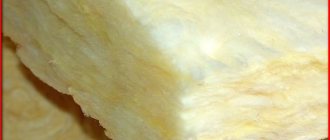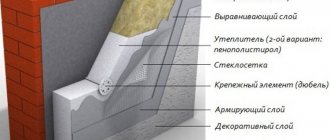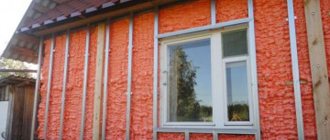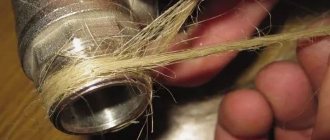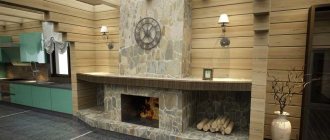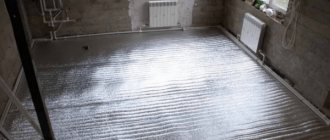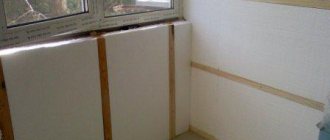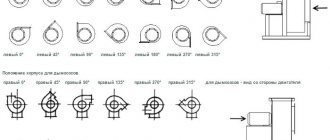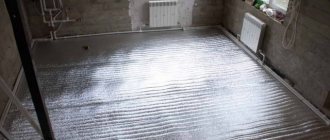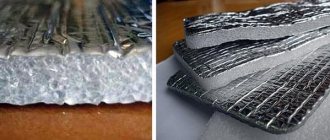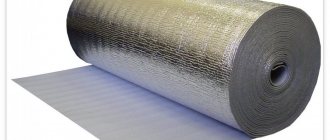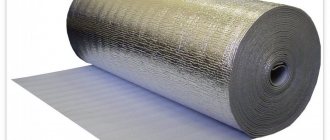GENERAL DESCRIPTION OF ISOLON PPE
In recent years, a large number of materials based on polyethylene and polypropylene have appeared on the construction market.
Despite the abundance of brands, materials produced using propane-butane mixture foaming technology (gas-filled materials) have similar physical properties and technical characteristics. Analyzing them, as well as taking into account the comprehensive requirements and features of the construction profile of the use of new materials, preference should be given to the IZOLONPPE brand material, the production of which is based on the use of physically cross-linked polyethylene foam with a cross-linked cellular structure. ISOLON PPE is hygienically clean, consistently elastic, closed-porous with a low density of 30 to 200 kg/m3, practically vapor-tight and low-hygroscopic, with a very low percentage of water absorption - less than 1% (by volume), a good heat insulator and noise protection against shock transmission of sound, which has high resistance to atmospheric influences, including ultraviolet radiation, does not lose flexibility and elasticity at - 600C, and can withstand long-term exposure to + 1250C.
The advantages of this material over those used for heat and sound insulation in the construction of residential and public buildings (mineral wool and fiberglass boards, polystyrene foam, polyurethane foam, soft wood-fiber boards and others) lie primarily in their environmental cleanliness and the preserved stability of all basic operational properties ( thermal insulation and acoustic indicators, moisture resistance and hydrophobicity, elasticity and elasticity) for a long period of time under all operating conditions.
Comparative table of properties of various insulating materials
| Material type | Properties | ||||||
| vapor insulation | thermal insulation | sound insulation | noise insulation | waterproofing | resistance to deformation | environmental friendliness | |
| Mineral wool | — | + | — | + | — | — | — |
| Polyurethane foam | — | ++ | ++ | + | — | + | + |
| Expanded polystyrene | — | ++ | + | — | + | — | + |
| Tree | — | + | ++ | — | — | ++ | ++ |
| ISOLON NPE with non-crosslinked cell structure | + | + | — | — | + | — | + |
| ISOLON PPE physically cross-linked polyethylene foam | + | ++ | + | ++ | ++ | ++ | + |
In addition, ISOLON has good microbiological, oil, oil and gasoline resistance, and is compatible with almost any building materials.
IZOLON serves as a heat- and sound-insulating underlay for parquet and various floor coverings, sealing of joints, doors, windows against dust, noise, moisture, covering material for concrete hardening, protective and shock-absorbing packaging for household and audio/video equipment, devices for various purposes, furniture, glass and ceramic products, cushioning material of various thicknesses and densities in bags, backpacks, folders, etc.
Taking into account all of the above, with close cooperation and on the basis of developments of the Central Research and Design Institute of Residential and Public Buildings (Moscow), recommendations were developed for the use of elastic polyethylene foam in residential buildings, in order to determine the specific, optimal place of application in construction and areas energy-saving modification of highly efficient insulating material - ISOLON. Recommendations for the use of noise and vibration insulation ISOLON in residential buildings, its use as thermal insulation of external structures and pipelines of utility networks, as well as insulation of internal structures to prevent the transfer of vibration and impact noise to adjacent premises are intended for architects and design engineers, as well as also engineering and technical workers of construction specialties.
One of the reasons affecting the comfort of indoor conditions is noise transmitted through the load-bearing structures of the building. One of the ways to combat noise and improve the sound insulation of floors is to install a “floating floor”, which involves the presence of an insulating layer between the floor and the “screed”. The use of ISOLON PPE as a soundproofing layer in the construction of a floating floor provides a significant increase in design parameters in comparison with the traditional options used today.
The use of ISOLON PPE makes it possible to significantly reduce the thickness of the “pie” of the interfloor ceiling, which relieves the load-bearing structural parts of the building and provides a gain in usable area during high-rise construction, prevents corrosion of steel pipes and compensates for linear extensions of underground pipelines.
Calculations of the effectiveness of using ISOLON PPE at the given costs, taking into account its durability in structures and the stability of retaining properties, show that its use as heat and noise insulation, despite the one-time higher cost compared to mineral wool and fiberglass boards and expanded polystyrene, is more appropriate and is beneficial not only economically, but also for preserving and maintaining comfort in buildings in all weather conditions, as well as for the purpose of saving energy costs. Thus, ISOLON PPE, as a new material, is not only competitive with those used, but also brings new quality to residential and industrial construction - in terms of preventing heat losses and solving acoustic problems. IZOLON is highly resistant to atmospheric influences, including ultraviolet radiation; does not lose flexibility and elasticity at temperatures of –60 °C and below, does not break when bending, and can withstand long-term exposure to +125 °C, while polystyrene foam does not exceed 70 °C, and PVC does not exceed 105 °C.
ISOLON is hydrophobic and non-hygroscopic, and, therefore, does not accumulate water on the surface, which is extremely important when insulating pipelines. It prevents corrosion of steel pipes. ISOLON - does not allow the transmission and maintenance of flames during a fire and contributes to the extinction of the ignition source. When exposed to fire, it breaks down into carbon dioxide and water and does not form toxic substances. During combustion, it does not melt to a state of fluidity, but decomposes, evaporating in the form of carbon dioxide and water vapor. ISOLON has a high resistance to water vapor diffusion and low water sorption capacity. All this makes it practically water- and vapor-tight.
These properties make it possible, when using it as insulation in structures, not to provide any additional hydro- and vapor protection, which is very important for reducing labor costs and maintaining the stability of its thermal insulation ability.
ISOLON - effective shock and sound insulation. It has a large number of varieties, which are additionally reported after the name of the material.
The use of polyethylene foam with a closed cell structure as a base material brings a unique combination of physical and chemical properties to the wide range of modern insulating materials offered and distinguishes it favorably from similar materials produced using the technology of polyethylene foaming with a propane-butane mixture (gas-filled materials). Of the entire range of polyethylene foam manufacturers, the Russian manufacturer, OJSC Izhevsk Plastics Plant, deserves special attention.
IZOLON brand products meet the highest standards in production technology and quality, have all the important characteristics in heat, sound, steam and noise insulation, and are a professional material in any of its areas of application. Due to its properties, the material finds its application in a wide variety of areas: from the manufacturing sector in the fields of tourism, sports and recreation to capital construction, industry and the automotive industry.
What is PPE and where is it used?
Foamed polyethylene for pipes (PPE, polyethylene foam) is a type of foam thermal insulation material that differs from expanded polystyrene in that it retains its flexibility and elasticity after polymerization. PPE is similar in consistency to foam rubber, but unlike it, it cannot withstand mechanical stress. Therefore, thermal insulation made of polyethylene foam on the floor or walls is practically not used.
Polyethylene foam has a porous structure with closed cells, due to which this thermal insulation for pipes does not absorb water and does not allow steam to pass through. It is this characteristic that distinguishes polyethylene foam from other thermal insulation materials.
Pipe insulation made of polyethylene foam is used in such areas as:
- cold and hot water supply;
- heating systems;
- pipes in refrigeration units;
- ventilation system;
- sewer systems.
In the industrial sector, foam pipe insulation is used in industries where the risk of fire insulation is minimized. In the domestic sphere, the use of foaming insulation materials is practically unlimited. PPE is a universal material that can be used both outside and inside buildings.
Differences between gas-filled and cross-linked polyethylene foam
The process of foaming polymers involves introducing gas or a gas-forming agent under pressure into the molten polymer, as a result of which gas bubbles form in the polymer structure. An important characteristic of polyethylene foams is the concept of “cross-linking,” which is understood as a modification of the polyethylene structure, leading to the creation of a cross-linked or network molecular model. Crosslinking is carried out chemically or physically. In the chemical method, the “cross-linking” substance forms cross-links between molecules. In the physical method, the carbon-hydrogen bonds of polyethylene are affected by a flow of charged particles (a flow of electrons or gamma rays). With this effect, some of the bonds are destroyed, carbon becomes the owner of a free bond, which is realized by combining with the same free bond in the neighboring molecular chain. Thanks to this, individual macromolecules of polyethylene are united by a network of intermolecular bonds. A modification of polyethylene occurs, called “cross-linking”.
The “stitching” technology allows you to increase the durability and reliability of maintaining quality indicators for the entire service life of ISOLONA PPE. This is explained by the fact that with such a structure, the pore walls retain stable, stable strength and elasticity over time, do not collapse or deform under load, while gas-filled materials are subject to compression and loss of elasticity with the destruction of the pore walls. This phenomenon occurs not only under load, but also during natural aging (destruction) of the material.
When the elasticity of the pore walls is lost and they are destroyed, shrinkage occurs, heat and sound insulation performance deteriorates, which, in turn, sharply reduces the operating comfort of buildings and entails unnecessary energy costs. In addition, sanitary and hygienic conditions indoors change over time due to the release into the air of gases (steam-butane) contained in the pores of these materials (necessary for the technological conditions of foaming), while the physical cross-linking of the structure prevents the formation of a structure in it. other gases other than atmospheric air.
Non-crosslinked polyethylene foam (Izolon NPE, Poliizol, Izokom, Penofol, etc.) has a pronounced bubble texture (Fig. 1) and a wavy surface (Fig. 2) in contrast to physically cross-linked polyethylene foam (Izolon PPE), the cut of which is more uniform and the surface flat.
| Fig 1. | Fig 2. |
The area of use of gas-filled materials (IZOLON NPE, POLIIZOL, PENOFOL, etc.) due to lower thermophysical parameters, inability to bear mechanical loads and relatively low durability, is defined mainly as an inexpensive packaging material. The production of cross-linked foams is quite expensive, but the ever-increasing demands on foamed polymers are leading to the increasingly widespread use of “cross-linked” foams, i.e. ISOLONA PPE, displacing gas-filled polyethylene (POLIZOL, PENOFOL, ISOKOM, etc.) from the consumer market.
Depending on the production technology and the raw materials used, the following types of ISOLONA PPE are distinguished:
- PPE and PPE-L are physically cross-linked polyethylene foam, foamed in a vertical oven, and have a cross-linked structure. Produced according to a 3-stage vertical foaming process (extrusion, cross-linking, foaming).
- PPE NR is a physically cross-linked polyethylene foam foamed in a horizontal oven.
- PPE NX is a chemically cross-linked polyethylene foam foamed in a horizontal oven.
ISOLONA PPE grades are determined by the foaming ratio (from 05 to 35) and thickness (from 0.8 to 6 mm for a single-layer material, up to 50 mm for a multi-layer material).
ISOLON PPE-L, PSEV-L and NPE-L are produced by lamination method, i.e. heating ISOLON sheets and joining them under pressure.
PPE FR, PPE Cl.1. and NPE FR - brands with the addition of fire retardants (fire extinguishing additives).
- Wide range of thicknesses (from 0.8 to 50 mm)
- excellent physical and mechanical properties
- It is possible to supply material with fire extinguishing additives (FR type)
- selection of softness according to type and brand
- ordered closed-cell structure
- Excellent thermoplastic properties, especially thermo-forming and molding properties
- wide operating temperature range
- excellent thermal insulation properties
- very good impact sound insulation
- low water absorption value
- very low vapor permeability
- chemical inertness
- no odor
- environmentally and chemically neutral
- safe disposal through recycling, incineration.
Floor insulation
Quite often, this heat insulator is used for floor insulation work. When carrying out floor insulation work, there are some nuances that you should be aware of. Only in this case can the quality of the procedure be ensured.
An event using this insulation can be carried out in one of two ways. The first option involves using during work, in addition to the main material, an additional heat insulator. Often the choice is made in favor of mineral wool. The process itself begins with surface preparation. Next, the slats are fixed to the base. Dowels are used to securely fix them. A distance of 50 cm must be maintained between the bars.
For high-quality installation of insulation, you need to scrupulously study the nuances of this matter.
Then mineral wool is laid between them, and foil insulation is laid on top of the slabs. It is secured to the slats using dowels. An important point when performing this operation is that the joints of the sheets must be located on the slats. They must be glued using metallized tape. With its help, maximum tightness of the sheets is ensured. After this, a second row of slats is mounted on the isolon , located perpendicular to the first. Next, the plywood sheets are laid. To secure them, ordinary self-tapping screws are used. Upon completion of the work, installation of the floor covering is carried out.
The second option excludes the use of additional thermal insulation material. Izolon is laid on wooden slats. It is placed in one layer end-to-end. To eliminate seams, you must use metallized tape. Then plywood should be laid on the insulation layer, and then secured with self-tapping screws. Flooring material is laid on top of them. Usually laminate or parquet boards are used. To improve the performance of a “warm floor” system, isolon PPE-L is usually laid on the base.
Areas of application of ISOLON:
- automobile, mechanical engineering
- construction
- oil industry
- production of refrigeration equipment and air ducts
- consumer goods (products for sports and recreation, shoes, etc.)
- production of single- and double-sided tapes
- leather goods (lining for bags, suitcases, folders, etc.)
From a wide range of types and brands of ISOLON, you can choose material parameters that meet the individual requirements of each consumer.
Examples of using isolon in construction:
| Application area. | Description. |
| Thermal insulation of wall partitions and external walls of buildings. | Thermal insulating layer of isolon between and internal panels of private houses, outbuildings, garages, basements, balconies, etc. |
| Impact and sound insulation of floors (floating floors) | Izolon sheets are used as acoustic and heat-insulating partitions between concrete floors and floors. |
| Underlay for parquet, laminate boards and various floor coverings. | Isolon sheets to provide shock-sound and thermal insulation and as a barrier against rising water vapor (NPE grade isolon is recommended) |
| Laying under artificial turf. | Izolon sheets as shock-absorbing bedding for artificial turf. |
| Sealant for slate and tiles. | An isolon profile used as a seal under slate or other corrugated surfaces for thermal insulation, protection against dust penetration, prevention of moisture condensation and noise reduction. |
| Compensation pillows. | Isolon mats used to compensate for linear elongations during underground laying of hot and cold water supply pipelines using the ductless method. |
| Tunnel insulation. | Isolon sheets for thermal insulation, as well as to prevent the penetration of groundwater with the subsequent formation of ice layers. |
| Sheets for concrete curing. | Sheets preventing heat loss due to hydration during concrete laying at low temperatures. |
| Pipe insulation. | Izolon strips for thermal insulation (reflective insulation) of hot and cold water supply pipes. |
| Insulation of ventilation pipes. | Isolon sheets or floorings for thermal and sound insulation of air conditioning units. |
| Joints of concrete sidewalks. | Sheets or decking between concrete blocks to reduce stress and prevent cracking. |
| "Floating" stair steps. | Sheets for impact sheet insulation from the floor and side walls. |
| Sealing tapes. | Sealing joints of prefabricated building elements and structures. Primary seal for expansion joints or non-bonding backing for cold air seals. |
| Sliding membrane | A strip of isolon as a partition between lightweight concrete structures. |
| Window insulation tape. | Izolon tape as a sealing connection between the glass and the frame. |
| Tape for plasterboard profiles | Izolon tape with a self-adhesive layer forms a soundproofing sealing layer between building structures and the guide profiles of plasterboard partitions. |
The given list of areas of application of ISOLON is incomplete and serves only as a basis for new ideas.
Crosslinked and non-crosslinked polyethylene foam
There are two types of PPE - uncrosslinked and crosslinked. These are different products with their own characteristics.
Thanks to cross-linking, the fabrics improve their elasticity and strength characteristics. The technology ensures the creation of a memory effect, in which the material returns to its original shape after pressure.
Due to the special characteristics, the scope of application of stitched fabrics is expanding, including the creation of complex insulation (effectively protects against low temperatures and impact noise).
Non-crosslinked PPE has less elasticity and is not ready for too high loads. The main purpose of such canvases is the production of packaging (the material is not suitable for construction work).
Soundproofing tape made of ISOLONA PPE
One of the decisive advantages of plasterboard when choosing materials for interior decoration is its high heat and sound insulation properties. Installation of plasterboard boards also implies their complex use with other components.
They often try to save money on them, grossly violating technological requirements and negating all the advantages of dry construction systems.
One of these component elements is soundproofing or, using a name that is well-established on the Ukrainian building materials market, sealing tape. A partition made of plasterboard slabs, mounted without soundproofing tape, can be compared to a sensitive screen that attracts and amplifies sound and vibrations from the walls of the entire building. In this regard, it is indicative that in Germany the use of soundproofing tape for interior decoration is strictly mandatory according to the so-called “Building Regulations” (Bauordnung).
Soundproofing tape is a rolled strip of elastic polyethylene foam (izolon) with a closed-cell structure, rolled into a roll 30 meters long and 3 mm thick, with a self-adhesive layer applied to one of the surfaces.
Advantages and disadvantages
About the advantages of the material:
- Like all foamed polymers, PPE has a low thermal conductivity coefficient - 0.035 W/(m deg).
- The material has good shock-absorbing properties. Foamed polyethylene is used to make: packaging (density 25-33 kg/m3), flooring (density 300 kg/m3), gaskets for equipment (300-500 kg/m3).
- Foamed polyethylene has dielectric properties, so self-extinguishing PPE is used to make electrical insulation for high-frequency cables. The dielectric constant of PPE is in the range of 1.4...1.5 (water - 81, vacuum - 1).
- PPE is an inert material that does not enter into chemical reactions.
- It is also a lightweight and waterproof material; insects and mice do not eat it. And most importantly, it is inexpensive.
It also has disadvantages:
- Foil-coated PPE will work as thermal insulation only if there is at least 2-3 cm of air space in front of the foil layer.
- Above 100 0 C, the material begins to melt and then burn. It can only be used in rooms with a high specific fire load.
Characteristics of isolon:
- excellent shock and sound insulation;
- almost zero water absorption;
- softness, elasticity and low weight of isolon, which makes it easy to work with the material isolon;
- retains elasticity at temperatures from -80°C to +100°C;
- durability, resistance to fungal infections, oxidation, ultraviolet radiation, weak alkalis, weak acids, climatic conditions;
- absence of plasticizers, which means environmental safety.
Advantages and disadvantages of polyethylene foam
Pipe insulation made of foamed polyethylene is easily installed on both ready-made and assembled pipelines. This quality and other advantages of the material make PPE the most popular insulation for pipes.
Advantages of using foamed polyethylene:
- long service life (up to 100 years);
- low degree of thermal conductivity;
- high efficiency as a heat insulator;
- high degree of sound insulation;
- impermeability to steam and moisture;
- pipeline protection from condensate;
- high coefficient of resistance to biological, chemical and electrical influences;
- resistance to temperature changes in a fairly wide range of 60 to +90 degrees;
- absolutely environmentally friendly - does not emit harmful substances either during combustion or during operation;
- Retains its shape for a long time and does not crack even when compressed.
Areas of use
Soundproofing sealing layer between building structures and guide profiles of plasterboard partitions. Before installation, the soundproofing tape is applied with the self-adhesive side to the guide profile.
Depending on the profile width, the soundproofing tape is offered in four versions:
UD 27 width 30 mm
UW 50 / CW 50 width 50 mm
W 50 / CW 75 width 70 mm
UW 100 / CW 100 width 90 mm
News: an alternative to PPE - the new insulation "RosEcoMat"
The new insulation made from hemp or flax "RosEcoMat" for private housing construction is a worthy alternative to foamed polyethylene foam. This is an environmentally friendly material that has already proven itself well in construction and repair work.
Advantages of RosEcoMat insulation:
- long service life while maintaining initial characteristics;
- environmental safety (can be used in medical and children's institutions);
- excellent hygroscopicity and vapor permeability;
- reliability and reasonable price;
- high sound insulation properties and versatility.
RosEcoMat products are already successfully sold not only in the Russian Federation and the Commonwealth countries, but are also beginning to conquer the European market. Read more about hemp or flax insulation on the supplier’s website.
TRADE SPECIFICATIONS
Product range
The table below gives an overview of existing ISOLONA brands.
Depending on the required foam thickness, testing may be necessary.
| Brand | 05 | 07 | 10 | 15 | 20 | 25 | 30 | 35 |
| Apparent density, kg/ m3 | 200 | 140 | 100 | 66 | 50 | 40 | 33 | 29 |
| PPE | X | — | X | X | X | X | X | X |
| PPE FR | — | — | — | — | X | X | X | X |
| PPE NR | X | X | X | X | X | X | X | X |
| PPE NH | X | X | X | X | X | X | X | X |
ISOLON is supplied in rolls and sheets. Linear parameters are given in the table:
| Brand | Nominal thickness, mm | Thickness tolerance, mm | Width after edge trimming, mm | Optimal length, m | Admission to length, % |
| PPE | |||||
| 0501 | 1,0 | ± 0,10 | 600-1040 | 500 | +5 |
| 0502 | 2,0 | ± 0,20 | 600-1040 | 230 | +5 |
| 0503 | 3,0 | ± 0,30 | 600-1040 | 160 | +5 |
| 1001 | 1,0 | ± 0,10 | 800-1300 | 500 | +5 |
| 1002 | 2,0 | ± 0,20 | 800-1500 | 230 | +5 |
| 1003 | 3,0 | ± 0,30 | 800-1500 | 160 | +5 |
| 1004 | 4,0 | ± 0,40 | 800-1500 | 120 | +5 |
| 1501 | 1,0 | ± 0,10 | 900-1500 | 500 | +5 |
| 1502 | 2,0 | ± 0,20 | 900-1500 | 230 | +5 |
| 1503 | 3,0 | ± 0,30 | 900-1500 | 160 | +5 |
| 1504 | 4,0 | ± 0,40 | 900-1500 | 120 | +5 |
| 2001 | 1,0 | ± 0,10 | 1000-1500 | 500 | +5 |
| 2002 | 2,0 | ± 0,20 | 1000-1500 | 230 | +5 |
| 2003 | 3,0 | ± 0,30 | 1000-1500 | 160 | +5 |
| 2004 | 4,0 | ± 0,40 | 1000-1500 | 120 | +5 |
| 2005 | 5,0 | ± 0,50 | 1000-1500 | 100 | +5 |
| 2502 | 2,0 | ± 0,20 | 1000-1500 | 230 | +5 |
| 2503 | 3,0 | ± 0,30 | 1000-1500 | 160 | +5 |
| 2504 | 4,0 | ± 0,40 | 1000-1500 | 120 | +5 |
| 2505 | 5,0 | ± 0,50 | 1000-1500 | 100 | +5 |
| 3002 | 2,0 | ± 0,20 | 1000-1500 | 230 | +5 |
| 3003 | 3,0 | ± 0,30 | 1000-1500 | 160 | +5 |
| 3004 | 4,0 | ± 0,40 | 1000-1500 | 120 | +5 |
| 3005 | 5,0 | ± 0,50 | 1000-1500 | 100 | +5 |
| 3502 | 2,0 | ± 0,20 | 1000-1500 | 230 | +5 |
| 3503 | 3,0 | ± 0,30 | 1000-1500 | 160 | +5 |
| 3504 | 4,0 | ± 0,40 | 1000-1500 | 120 | +5 |
| 3505 | 5,0 | ± 0,50 | 1000-1500 | 100 | +5 |
| 3506 | 6,0 | ± 0,60 | 1000-1500 | 80 | +5 |
| Brand | Nominal thickness, mm | Thickness tolerance, mm | Trimming width after edge, mm | Optimal length, m | Admission to length, % |
| PPE – L | |||||
| 1506 | 6,0 | ± 0,60 | 1000-1500 | 80 | +5 |
| 1508 | 8,0 | ± 0,80 | 1000-1500 | 60 | +5 |
| 1510 | 10,0 | ± 1,00 | 1000-1500 | 50 | +5 |
| 1512 | 12,0 | ± 1,20 | 1000-1500 | 40 | +5 |
| 1515 | 15.0 | ± 1,50 | 1400 | 2 | +5 |
| 1520 | 20.0 | ± 2.00 | 1400 | 2 | +5 |
| 1530 | 30.0 | ± 3.00 | 1400 | 2 | +5 |
| 1540 | 40.0 | ± 4.00 | 1400 | 2 | +5 |
| 1550 | 50.0 | ± 5.00 | 1400 | 2 | +5 |
| 2006 | 6,0 | ± 0,60 | 1000-1500 | 80 | +5 |
| 2008 | 8,0 | ± 0,80 | 1000-1500 -.-, | 60 | +5 |
| 2010 | 10,0 | ±1.00 | 1000-1500 | 50 | +5 |
| 2012 | 12,0 | ± 1,20 | 1000-1500 | 40 | +5 |
| 2015 | 15.0 | ± 1,50 | 1400 | 2 | +5 |
| 2020 | 20,0 | ± 2.00 | 1400 | 2 | +5 |
| 2030 | 30.0 | ± 3.00 | 1400 | 2 | +5 |
| 2040 | 40.0 | ± 4.00 | 1400 | 2 | +5 |
| 2050 | 50.0 | ± 5.00 | 1400 | 2 | +5 |
| 2506 | 6,0 | ± 0,60 | 1000-1500 | 80 | +5 |
| 2508 | 8,0 | ± 0,80 | 1000-1500 | 60 | +5 |
| 2510 | 10,0 | ± 1,00 | 1000-1500 | 5O | +5 |
| 2512 | 12,0 | ± 1,20 | 1000-1500 | 40 | +5 |
| 3006 | 6,0 | ± 0,60 | 1000-1500 | 80 | +5 |
| 3008 | 8,0 | ± 0,80 | 1000-1500 | 60 | +5 |
| 3010 | 10,0 | ± 1,00 | 1000-1500 | 50 | +5 |
| 3012 | 12,0 | ± 1,20 | 1000-1500 | 40 | +5 |
| 3015 | 15,0 | ± 1,50 | 1000-1500 | 2 | +5 |
| 3020 | 20,0 | ± 2,00 | 1000-1500 | 2 | +5 |
| 3030 | 30.0 | ± 3.00 | 1000-1500 | 2 | +5 |
| 3040 | 40,0 | ± 4.00 | 1000-1450 | 2 | +5 |
| 3050 | 50.0 | ± 5.00 | 1000-1450 | 2 | +5 |
| 3506 | 6,0 | ± 0,60 | 1000-1500 | 80 | +5 |
| 3508 | 8,0 | ± 0,80 | 1000-1500 | 60 | +5 |
| 3510 | 10,0 | ± 1,00 | 1000-1500 | 50 | +5 |
The optimal roll length is calculated taking into account the roll diameter that is optimal for loading vehicles. At the customer's request, the roll length can be longer than optimal.
As standard, IZOLON is supplied without edge trimming. On request we can produce the material with edge trimming.
Width tolerances:
Without trimming - ±50 mm;
With trimming - ±5 mm.
It is possible to agree with the customer on other lengths, widths and thicknesses (fixed in a separate specification).
ISOLON is supplied in rolls (up to 12 mm thick) or in sheets (12 to 50 mm thick).
ISOLON rolls are wound on cardboard spools with a diameter of 78 or 152 mm.
Due to the continuity of the foaming process, there may be joints in the roll. The number of joints depends on the length of the roll. The minimum distance between two joints or the end/beginning of a roll and the joint is 10 m.
| Isolon length, m | Number of joints | |
| Single layer isolon | Multilayer isolon | |
| Up to 50 inclusive | 0 | 1 |
| Over 50 to 100 | 1 | 2 |
| — 100 to 150 | 2 | 4 |
| — 150do200 | 3 | 6 |
| Standard color | White gray |
| Coloring (extra charge) | Silver gray |
| Dark grey | |
| Black | |
| Yellow | |
| Red | |
| Blue | |
| Green | |
| Violet | |
| Orange | |
| Khaki | |
| Other colors | By agreement with the customer, it is possible to produce ISOLON in various colors (this may require trial work) |
Slight variations in color within a roll and between batches are acceptable. Prolonged exposure to ultraviolet radiation may cause the product to change color. The production uses exclusively dyes that do not contain cadmium, as well as dyes approved for contact with food.
Below are the density indicators of ISOLONA PPE, PPE NR, PPE NH and PSEV with tolerances:
| Brand | 05 | 07 | 10 | 15 | 20 | 25 | 30 | 35 |
| Type | ||||||||
| PPE (kg/m3) | 200±20 | 150±15 | 100±10 | 66±6 | 50+5 | 40+4 | 33±3.3 | 29±2.9 |
| PPE HP (kg/m3) | 200±30 | 150±15 | 100+10 | 66±8 | 50+8 | 40+6 | 33±5 | 28+4 |
| PPE NH (kg/m3) | 200±30 | 150±15 | 100±10 | 66±8 | 50±8 | 40+6 | 33±5 | 28+4 |
Please remember that this specification is indicative only. Tolerances for the batch are specified in a separate specification for each order.
During the foaming process, the formation of shells and bubbles with a diameter of no more than 2.5 mm and a depth within the thickness tolerance is allowed on the surface of ISOLON, in an amount of no more than 3 pieces per 1 dm2. If the indicators are critical, please contact us for control samples.
ISOLON has remarkable stability of parameters at elevated temperatures. However, IZOLON is a thermoplastic material, as a result of which linear dimensional shrinkage occurs.
The upper operating temperature at no load is the temperature at which linear shrinkage along the length and width (x, y direction) after storage in a ventilated oven for 24 hours does not exceed 5% (preliminary foam temperature 23 ° C).
For different types of ISOLON this temperature is:
Type Temperature °C
PPE, PPE NR, PPE NH 100
PSEV 80
NPE 80
Under short-term high-temperature loads (for example, during thermoforming), the indicated linear shrinkage may be greater.
Izolon with the FR or Cl.1 index is produced with the addition of fire retardants and is classified as a low-flammable material. The concentration of fire extinguishing additives can be different in accordance with customer requirements for the flammability of ISOLON.
| without added flame retardant | with added flame retardant | |
| thickness, mm | 1-15 20-50 | 1-15 20-50 |
| flammability group according to GOST 30244 | G2 G4 | G2 G2 |
| flammability group according to GOST 30402 | B2 B2 | B2 B2 |
| smoke generating ability group GOST 21. 1.044 | DZ DZ | DZ DZ |
IZOLON can be supplied with corona discharge surface treatment in cases where the customer requires increased surface wettability for subsequent processing (for example, for printing, adhesive coating, etc.). In this case, the maximum thickness of the processed sheet is 4 mm.
The type of processing (single or double sided) is indicated on the label of each roll. In the case of one-sided processing, the roll is wound inward with the treated surface.
Polyethylene foam - what is it: characteristics
There are many types of PPE on the construction market. Brands of isolon vary depending on the method of its manufacture and execution. It can be square or rectangular sheets, the thickness of which varies from 15 to 100 mm. Such plates are characterized by elasticity and softness.
Izolon can be in rolls and have a standard panel width (80 cm - 1.5 m) and length (10 - 200 m), thickness (5 mm - 8 mm).
One or two layers of foil coating can be added to the isolon composition. It can be thin aluminum or reinforced metallized film. During the lamination process, an outer reflective layer is attached to the PPE. The adhesion of the materials is very reliable and durable, which indicates the high quality of the material.
Technical characteristics of isolon:
- Diverse range of operation;
- Thermal conductivity;
- Vapor tightness;
- Water resistance;
- Strength;
- Soundproof.
Izolon PPE has unique properties, for example, foaming ratio. Thanks to the first two numbers on the marking, you can determine the foaming ratio, then the thickness of the material. When purchasing, it is important to pay attention to what the material will be used for. For the substrate under the laminate, choose a thinner isolon, for heat and vapor barrier - a denser one.
